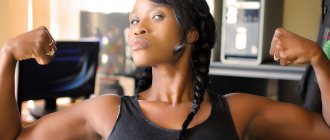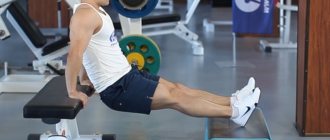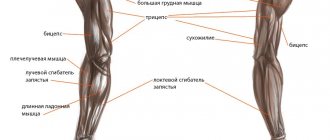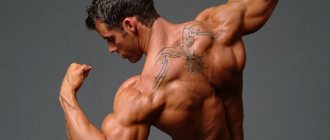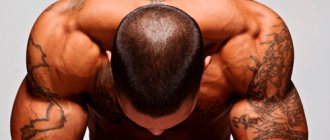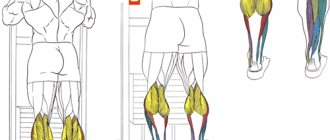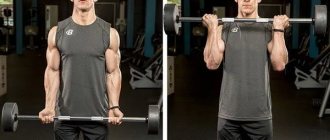Introduction
Biceps are a part of the body that many unreasonably consider to be the main one and often spend too much time training them, forgetting about other muscle groups. You can often see guys in the gym who pump their biceps two or even three times a week, stroking their pride with the misconception that “the more often you pump, the faster it will grow.” But we are not talking about them now. Here we will describe the most effective exercises for the biceps, as well as for the forearms.
In this article we will look at the muscles that are somehow involved in flexing the elbow joint. These are primarily the biceps brachii muscle (biceps), brachialis muscle (brachialis) and forearm muscles. As we already understood, biceps are needed to bend the arms at the elbows. The muscles of the forearms help with the work of the wrists. Accordingly, training the biceps and brachialis consists of all kinds of arm curls. The forearms are trained by flexing and extending the wrists.
Biceps muscle anatomy
The biceps is the biceps brachii muscle (lat. musculus biceps brachii). The name is due to the fact that the biceps consists of two parts - short and long, each of which has its own attachment point and mechanics of movement. The more developed the biceps muscles are, the more visible their components become.
The long part of the biceps brachii muscle is located on the outer part of the arm (number 1 in the figure), the short part is on the inner part (number 2). Among other things, the pumping of the biceps is influenced by the involvement of the brachialis muscle located directly next to it.
As if pushing the biceps up, the brachialis muscle visually increases its size - which is one of the secrets of professional arm training. In addition, the degree of pumping of the forearms also affects the perception of the biceps.
Standing biceps curl
This barbell biceps exercise targets the middle, top, and bottom of the biceps, as well as the upper part of the forearm. Basic exercise, best for building mass and strength. Recommended for everyone, from beginner to experienced athlete at the very beginning of biceps training.
Exercise technique
1. Place the desired weight on the barbell. Stand straight, feet shoulder-width apart, feet parallel, toes slightly to the sides. Take the barbell shoulder-width apart with an underhand grip. 2. In the starting position, the back maintains a natural curve, the head looks forward. The arms are straightened, but not locked at the elbows. The barbell in your hands is at hip level. 3. Take a deep breath and, holding your breath, bend your elbows. At the top point, the bar should be at the level of your upper chest. 4. You can exhale after overcoming the most difficult section of the amplitude. Then immediately, without delay, lower the barbell to its original position. 5. You shouldn’t linger at the bottom point either. As soon as the bar reaches the lowest point, immediately change the direction of its movement.
Technique tips
- Using a standard shoulder-width underhand grip is the most effective way to effectively work both the biceps and brachialis.
- Using a non-standard overhand grip, shoulder-width apart, is the most effective way to effectively work the brachioradialis muscle.
- Throughout the entire approach, keep your back straight and do not sway. By pushing your body forward or backward to help lift the weight, you take the stress off your biceps.
- During the positive phase (rising), the elbows are strictly fixed at the sides. There is no need to bring them forward, otherwise the load from the biceps goes to the front deltoids.
- There is no point in using too much weight in the exercise. It will provoke you to swing and throw the barbell by inertia, which will reduce the effectiveness of the exercise.
- Too much weight will also significantly reduce the range of motion of the barbell, which will prevent you from lifting it high enough at the top.
- A variation with an angled grip is possible. For this, an EZ-bar or W-bar is used (see article). The more the hand is turned with the thumb up, the more the brachialis is activated.
- A variation with a parallel grip is possible. For this, an oval bar is used (see ibid.). In the position where the palms are facing each other, the brachialis is pumped efficiently.
- A variation is possible with an underhand grip wider than shoulder width. In the case of a straight bar, this grip allows you to effectively work the inner head of the biceps.
- A variation is possible with a grip from below, narrower than the shoulders. In the case of a straight bar, this grip allows you to effectively work the outer head of the biceps.
Top 11 isolation exercises for biceps
Alternating arm curls with dumbbells
It is performed both standing and sitting on a bench. The ideal option would be to perform the exercise with your back resting on the back of the bench. The exercise is performed with the hand supinated at the top point of the amplitude. Like other biceps exercises, alternating dumbbell curls are performed in a concentrated manner. Returning the hand to its original position occurs slowly.
Concentrated one-arm dumbbell curls
Performed while sitting. The athlete should rest his hand on his leg with the back of his shoulder. The arm should be straight and down. This is a difficult exercise due to the fact that it deprives you of the opportunity to additionally help other muscles. This is achieved, firstly, by a sitting position, and secondly, by fixing the elbow.
Read more about concentration curls →
Hammer Curl
Can be performed both standing and sitting with alternating or simultaneous bending of the arms. When performing the movement, the palms should be turned towards the body. This exercise is aimed at developing the brachialis.
Read more about the exercise hammers with dumbbells →
One arm curl with lower pulley handle
The same is done while standing. Standing next to the machine, you need to take the handle with an underhand grip. This exercise creates a pump and is an alternative to dumbbell curls. Watch your technique and posture. The back should be straight, the body should not lean forward or lean back.
Arm curls with crossover handles
This is not the most popular exercise and is not often seen in the gym. It is performed standing. The athlete, holding both handles, bends his arms at the elbow joints at the same time. The exercise at the top of the amplitude looks like one of the bodybuilding poses showing off the biceps during a performance.
Read more about crossover biceps exercises →
Barbell Curl
The peculiarity of performing barbell curls is that you can grab the bar with a wide grip, thereby focusing the load on the short biceps bundle. The short bundle of the biceps plays an important role in the formation of the muscle. It gives more volume. The best way to perform this exercise is to work while sitting.
Z-Bar Curl
Using a Z-shaped bar reduces the stress on the joints of the hand. Otherwise, the exercise is no different from straight bar curls.
Curling arms in a Scott machine
A special feature of the exercise in the simulator, as well as on the Scott bench, is the fixation of the arm by placing the elbows on the surface of the “board”. This feature complicates the exercise because it makes it impossible to help the biceps with other muscles. By the way, the working weight in this exercise is much lower.
Scott Bench Curl
The exercise differs only in the use of free weight.
Overhand grip barbell curl
The exercise is performed identically to barbell curls, only with a reverse overhand grip. The exercise is intended to strengthen the joints of the hand.
Bend your arms at an angle of 45 degrees
This exercise does not allow you to work with a large working weight, but in this position the load on the spine is minimized.
Standing dumbbell curls
This biceps exercise with dumbbells targets the middle, top, bottom, brachialis and brachioradialis muscles. This is a basic exercise used to build mass and strength. Recommended for everyone, from beginner to experienced athlete at the beginning of biceps training.
Exercise technique
1. Select dumbbells of the desired weight and hold them in both hands with a neutral grip (palms facing each other). Feet hip-width apart, back straight. The head looks ahead. 2. Take a deep breath and, holding your breath, lift the dumbbells to your shoulders. The upward movement of the dumbbells is accompanied by a turn of the hands. At the top point, the palms face the shoulders. 3. You can exhale after passing the most difficult section of the amplitude. Then immediately, without delay, return the dumbbells to their original position by turning the hands back. 4. At the bottom point of the palm, look at the side of the thigh. As soon as they reach this position, immediately change their direction of movement.
Technique tips
- Make sure to keep your elbows on the sides of your body at all times. By pushing them forward, you transfer the load to the front deltoids, which reduces the effectiveness of the exercise.
- The arms are fully straightened at the lowest point, but not to the point of locking at the elbow joints. Fully straightening the arms places stress on the elbow, which can lead to injury.
- There is no point in keeping your palms turned back in the original position. In this position, the biceps tendons become twisted and the strength of the biceps is significantly reduced.
- To maximize your biceps contraction, at the top of the exercise, try to supinate (rotate away from you) your wrist as much as possible.
- By holding your breath, you help yourself stabilize your core position, and you can develop significantly more force while lifting the dumbbells.
- Don't rock your body forward or back in an attempt to help you lift the weight. This will significantly reduce the effectiveness of the exercise.
- Do not use excessive weight in the exercise. Firstly, it will not allow you to work in full amplitude, and secondly, at the moment of turning your hand, you can injure your wrist.
- Throughout the entire approach, the hands remain motionless. Secure them at the very beginning, do not bend or straighten them.
- A variation of alternate lifting of dumbbells with the left and right hands is possible. However, with this variation, you will bend over and swing your body, which will reduce the load on the biceps.
- A variation of performing the exercise with both hands at the same time is more preferable. This way the load and center of gravity are distributed evenly, which eliminates unnecessary body movements.
Seated dumbbell curls
This biceps exercise targets the middle, brachialis, and brachioradialis muscles. A formative exercise, used to build strength and thicken the shape of these muscles. Recommended for everyone, from beginner to experienced athlete in the middle of a biceps workout.
Exercise technique
1. Select dumbbells of the desired weight and hold them in both hands with a neutral grip (palms facing each other). 2. Sit on the edge of the bench. In the starting position, legs are hip-width apart, feet are parallel, and the back is straight. The head looks ahead. 3. Take a deep breath and, holding your breath, lift the dumbbells to your shoulders. The upward movement of the dumbbells is accompanied by a turn of the hands. At the top point, the palms face the shoulders. 4. You can exhale after passing the most difficult section of the amplitude. Then immediately, without delay, return the dumbbells to their original position by turning the hands back. 5. At the bottom point, the palms face each other. As soon as they reach this position, immediately change their direction of movement.
Technique tips
- Do not sit across the bench, otherwise the dumbbells will touch the bench at the bottom point and you will not be able to fully extend your arms.
- Don't lean forward or sway. All movement occurs exclusively at the elbow joint. Keep your back locked throughout the entire approach.
- Holding your breath while doing the exercise not only helps you stabilize your position on the bench, but also helps you develop significantly greater force.
- The elbows are fixed at the sides throughout the entire approach. By raising your elbows at the top of the dumbbell movement, you transfer the load from the biceps to the front deltoids.
- Lifting dumbbells at the same time is preferable to alternate lifting. This way the load and center of gravity are distributed evenly, which eliminates unnecessary body movements.
- Don't use dumbbells that are too heavy. They will not allow you to lift the dumbbells to their full amplitude, which will significantly reduce the effectiveness of the exercise.
Dumbbell curls at an angle
This exercise for the biceps muscles involves the middle and lower part of the biceps, the brachialis and the brachioradialis muscle. A formative exercise, used to build strength and thicken the shape. Recommended for advanced and more experienced athletes in the middle of a biceps workout.
Exercise technique
1. Select dumbbells of the desired weight and hold them in both hands with a neutral grip (palms facing each other). 2. Adjust the backrest to an angle of 45 degrees and sit on the bench. In the starting position, legs are hip-width apart, feet are parallel, and the back is straight. The head looks ahead. 3. Take a deep breath and, holding your breath, lift the dumbbells to your shoulders. The upward movement of the dumbbells is accompanied by a turn of the hands. At the top point, the palms face the shoulders. 4. You can exhale after passing the most difficult section of the amplitude. Then immediately, without delay, return the dumbbells to their original position by turning the hands back. 5. At the bottom point, the palms face each other. As soon as they reach this position, immediately change their direction of movement.
Technique tips
- To prevent you from sliding down the bench while lying down, also raise the saddle of the machine to a slight angle.
- If the raised saddle forces you to spread your legs wide and this interferes with the movement of the dumbbells, lift your legs off the floor and cross them together on the saddle.
- Holding your breath in this position is extremely important, since lifting your legs off the floor will help stabilize your body on the bench as much as possible.
- Do not swing your arms or throw dumbbells by inertia. All movement occurs exclusively in the elbow joints, the rest of the body is motionless.
- The elbows are fixed at the sides throughout the entire approach. By raising your elbows at the top of the dumbbell movement, you transfer the load from the biceps to the front deltoids.
- Lifting dumbbells at the same time is preferable to alternate lifting. It allows you to eliminate body movements and concentrate as much as possible on contracting your biceps.
- Don't use dumbbells that are too heavy. They will not allow you to lift the dumbbells to their full amplitude, which will significantly reduce the effectiveness of the exercise.
Dumbbell bicep curl “Hammer”
This exercise for biceps with dumbbells involves the lateral part of the biceps, brachialis and brachioradialis muscles. A formative exercise, used to thicken the biceps and forearm. Recommended for everyone, from beginner to experienced athlete in the middle of a biceps workout.
Exercise technique
1. Select dumbbells of the desired weight and hold them in both hands with a neutral grip (palms facing each other). Feet hip-width apart, back straight. The head looks ahead. 2. Take a deep breath and, holding your breath, lift the dumbbell to your shoulder. The upward movement of the dumbbell should not be accompanied by any rotation of the hand. At the top point, the palm remains in the same position. 3. You can exhale after passing the most difficult section of the amplitude. Then immediately, without delay, return the dumbbell to its original position at hip level. 4. At the bottom point, the palms face each other. As soon as one dumbbell returns to the starting position, immediately begin moving up with the other dumbbell.
Technique tips
- Make sure to keep your elbows on the sides of your body at all times. By lifting them forward, you transfer the load to the front deltoids, which reduces the effectiveness of the exercise.
- The arms are fully straightened at the lowest point, but not to the point of locking at the elbow joints. Fully straightening the arms places stress on the elbow, which can lead to injury.
- By holding your breath, you help yourself stabilize your core position, and you can develop significantly more force while lifting the dumbbells.
- Don't rock your body forward or back in an attempt to help you lift the weight. This will significantly reduce the effectiveness of the exercise.
- Do not use excessive weight in the exercise. It will not allow you to work at full amplitude, which will significantly reduce the effectiveness of the exercise.
- Throughout the entire approach, the hands remain motionless. Secure them at the very beginning, do not bend, straighten or unfold them.
- A variation of the exercise with both hands at the same time is possible. It allows you to eliminate unnecessary movements of the body and concentrate as much as possible on bending your arms.
EZ-barbell curl on Scott bench
This biceps exercise with a barbell targets the middle and bottom. An isolating exercise, used to lengthen the lower part of the biceps and raise its peak. Recommended for athletes of intermediate level and above in the middle of a biceps workout.
Exercise technique
1. Adjust the height of the desk so that its upper edge rests against your armpits, your back is straight, and your body position remains fixed throughout the entire approach. 2. Take an EZ bar (or W bar), place it on the bench supports and collect the desired weight on it. Hold the barbell shoulder-width apart. Sit down so that your triceps are pressed firmly against the desk. 3. In the starting position, the back is straight, the elbows are on the desk, the arms with the barbell are straightened, but not to the point of locking in the elbow joints. 4. Take a deep breath and, holding your breath, lift the barbell up. At the top point it should be at chin level. 5. You can exhale after overcoming the most difficult section of the amplitude. Then immediately, slowly, return the bar to its original position. 6. At the bottom point, the arms are fully straightened again, and the barbell changes its direction of movement without delay.
Technique tips
- Throughout the entire approach, your elbows should be pressed tightly to the desk. By tearing your elbows off, you severely overload the joints, which can lead to injury.
- Make sure that at the lowest point your arms do not extend until your elbow joints lock. Locking is dangerous not only for the elbows, but also for the biceps ligaments.
- Holding your breath while performing the exercise helps not only keep your back straight, but also develop significantly greater force while lifting the barbell.
- Keep your body still throughout the entire approach. Adjust your seat and desk so that you don't have to lift your butt off the bench or your elbows off the desk.
- If possible, use a Scott bench to perform the exercise while standing. This way you can better fix your posture and avoid unnecessary body movements.
- To maximally work out your biceps, you can pause for literally 1-2 seconds when passing the most difficult section.
- Variations of the exercise with different bars are possible (see article). For the most versatile muscle development, change the bars periodically.
How to train the biceps muscle
Biceps are synergists of the back muscles. In many back exercises they are included in the work. This, of course, tires the muscle and affects your performance in subsequent arm exercises.
Therefore, the best option for biceps growth is to train it twice a week: once with the back and once with the triceps or chest.
On back day, the biceps should not be overloaded, as you will not have enough energy to work them out effectively. So just get the blood flowing through your muscles.
But on a day when you don’t have back exercises in your program, load your biceps to the fullest. You can alternate exercises for biceps and triceps, combine training with shoulders or legs, do biceps trisets, double sets and other combinations.
To make it more convenient, we provide below a list of effective exercises for biceps in the fitness room.
Carefully familiarize yourself with the technique of performing them. If possible, do several repetitions in front of a mirror. Assess how well you feel the muscle working and how accurately you perform the movement. You can ask a friend, or better yet a coach, to watch you. After all, it’s always clearer from the outside. There's a lot you can't see with your own eyes. Sometimes it can be difficult to fully feel the work of muscles, since there is not enough experience.
And remember that purposefully pumping up only the biceps will only lead to a slight increase in the volume of the arms and strangely bent elbows. After all, undeveloped triceps will not be able to constantly restrain the trained biceps muscle.
The position of your hand in a relaxed state is the balance of the antagonist muscles. So, to maintain this balance, do both biceps and triceps exercises.
In addition, triceps make up two-thirds of the volume of your arms, so for harmonious development and effective mass growth, they should also be given attention.
Scott Bench Dumbbell Curls
This biceps exercise targets the middle and bottom of the biceps. An isolating exercise, used to highlight the lower part of the biceps and its peak. Recommended for advanced and more experienced athletes to complete their biceps training.
Exercise technique
1. Adjust the height of the desk so that its upper edge rests against your armpit, your back is straight, and your body position remains fixed throughout the entire approach. 2. Take a dumbbell of the desired weight and place one hand so that the triceps are pressed firmly to the desk. 3. In the starting position, the back is straight, the elbow lies on the desk, the arm with the dumbbell is straightened, but not to the point of locking in the elbow joint. The palm faces up. 4. Take a deep breath and, holding your breath, lift the dumbbell up. At the top point it should be at chin level. 5. You can exhale after overcoming the most difficult section of the amplitude. Then immediately, slowly, return the dumbbell to its original position. 6. At the bottom point, the arm is fully straightened again, and the dumbbell changes its direction of movement without delay. 7. After completing all repetitions for one arm, proceed to perform the exercise with the other arm. This will be one approach.
Technique tips
- Throughout the entire approach, the elbow should be pressed tightly to the desk. By tearing your elbow off, you put a lot of stress on the joint, which can lead to injury.
- The elbow should always be pointed straight down. If it is directed inward or outward, there is a possibility of dislocating the joint.
- Make sure that at the lowest point the arm does not extend until it locks in the elbow joint. Locking is dangerous not only for the elbow, but also for the biceps ligament.
- Holding your breath while performing the exercise helps not only keep your back straight, but also develop significantly greater force while lifting the dumbbell.
- Keep your body still throughout the entire approach. Adjust your seat and desk so that you don't have to lift your butt off the bench or your elbows off the desk.
- If possible, use a Scott bench to perform the exercise while standing. This way you can better fix your posture and avoid unnecessary body movements.
- To maximally work out your biceps, you can pause for literally 1-2 seconds when passing the most difficult section.
- Do not twist or bend your wrists while raising or lowering the dumbbell. This can cause a wrist dislocation.
- The option of performing the exercise with both hands at the same time is more preferable. This way you stabilize the position of the body and eliminate unnecessary body movements.
- Variations of the exercise with different grips are possible. Turning the hand upward with your thumb shifts the load on the brachialis. Turning the hand palm down loads the brachioradialis muscle.
- A variation of the exercise on the back side of the desk is possible. But be careful. In this position, the arm will hang freely, which can lead to excessive extension at the elbow.
Concentrated biceps curl
This biceps exercise with a dumbbell targets the middle and bottom. An isolating exercise, used to give the biceps a peak shape. Recommended for advanced and more experienced athletes to complete their biceps training.
Exercise technique
1. Sit on the edge of a bench and hold a dumbbell in one hand. The back is straight, legs are spread wide, feet rest on the floor. 2. In the starting position, bend over and rest the triceps of your working arm on your leg so that the arm is straightened, but not to the point of locking at the elbow. Place your other hand on your other leg. 3. Inhale and, holding your breath, lift the dumbbell up. At the top point, the dumbbell is at the level of the top of the chest. 4. You can exhale after overcoming the most difficult section of the amplitude. Then you can immediately, without delay, return the dumbbell to its original position. 5. At the starting point, the arm is fully straightened again. As soon as the dumbbell lowers to the starting point, immediately change the direction of its movement. 6. Having completed the required number of repetitions for one hand, transfer the dumbbell to the other and repeat all the above steps. This will be one approach.
Technique tips
- The triceps of the working arm should be pressed tightly against the leg, otherwise you will dangle your arm, throw the dumbbell by inertia, and significantly reduce the effectiveness of the exercise.
- Make sure that at the lowest point the arm does not extend until it locks in the elbow joint. Locking is dangerous not only for the elbow, but also for the biceps ligament.
- Holding your breath while performing the exercise will help maintain the natural curve of the spine and develop significantly greater force.
- Don't rock your body by leaning too far forward or back in an attempt to help you lift the weight. This will significantly reduce the effectiveness of the exercise.
- Do not use excessive weight in the exercise. It will not allow you to work at full amplitude, which will significantly reduce the effectiveness of the exercise.
- To engage all three muscles involved in curling the arm: biceps, brachialis, brachioradialis, perform the exercise while holding the dumbbell with your palm facing you.
- To target your biceps, start the movement with your palm facing you and then turn your hand so that at the top point your thumb is pointing away from you.
Best exercises
All exercises are divided into basic and isolated. The basic ones involve several muscle groups at once.
With basic exercises for biceps, everything is simple - classic pull-ups with a reverse grip engage this particular muscle. Performing the movement is very simple: grab the bar with a reverse grip, pull your body up to chest level and smoothly lower, returning to the starting position. Girls whose hands are too weak can perform the exercise in the gravitron. Men who go to the gym are advised to use additional weights or bands to increase the effectiveness of pull-ups.
Another basic movement is the barbell pull-up. This is done as follows.
- Stand straight, legs slightly apart. Take the bar with an overhand grip, hands close.
- Raise the barbell to your collarbones while spreading your elbows.
- Smoothly lower the projectile, returning to the starting position.
This movement works the biceps, deltoids, and upper back.
Barbell curls
One of the simple but very effective movements. Suitable for both beginners in the gym and experienced athletes who want to achieve pronounced arm hypertrophy in the shortest possible time. Beginners can perform with an empty bar, because its weight will be enough to force the muscles to work. The same advice is relevant for girls.
- Stand straight, feet pressed firmly to the floor, heel does not come off when moving. Place your feet shoulder-width apart. Grasp the barbell with an overhand grip.
- As you exhale, slowly raise the barbell to your shoulders, tensing your biceps muscle. At the top point, hold for two counts.
- As you inhale, straighten your arms, lowering the projectile down.
During movement, the elbows are constantly pressed to the body. The position of the hands on the apparatus depends on the goals: with a wide grip, the inner part of the biceps works, with a narrow grip, the outer part works. It is recommended to do the lifting slowly and smoothly in order to feel the increase in tension, but not jerkily. The projectile should be raised almost to shoulder level.
A similar exercise is curling the arms with an underhand grip. It is performed in a similar way, but the bar is taken in the palm from below, and the grip is slightly narrower than the shoulders.
Dumbbell curls
A movement without which no arm workout can be imagined. You can load both biceps at once, or do it alternately with the right and left.
- It is performed standing or sitting on a bench with the back raised. The feet must be firmly on the floor; it is important to exclude assistance from the body when performing with two hands, otherwise the effect on biceps growth is significantly reduced.
- Hold dumbbells in your hands with a regular grip.
- Raise the weight to your shoulder, turning your hand at the top point, then lower the weight, straightening your arms. Lifting is carried out while exhaling. Additionally, you can hold the tension at the top point to maximally load the working muscle.
The exercise can be performed without turning the wrist. This variation of the lift is called a “hammer”. This movement is best done alternately for the right and left hands, especially if a person has just started training.
The difference between these execution options is the shift in load - the lift with a turn puts more load on the outer head of the biceps muscle, and the “hammer” involves the inner head and forearm more. For beginners, it is best to perform while sitting on a bench, pressing your shoulder blades to your back. This eliminates core work and shoulder assistance when lifting weights.
On Scott's bench
The equipped rod should be installed on the stand in advance. It is convenient to perform the lift with a short bar equipped.
You need to sit on the bench, put your elbows on the music stand and take the apparatus. Bend your arms, bringing them to your shoulders, then lower them, stretching the muscles. All the time, the elbows remain in one position and are pressed tightly to the music stand. To avoid joint injuries, you do not need to fully straighten your arms and lower the barbell low. Beginners are advised to start with dumbbells. The Scott bench only targets the biceps and eliminates shoulder or body assistance while lifting the weight.
Upper block pull
The basic exercise targets the biceps, lats and forearms. It's very easy to do. It is necessary to set the desired weight on the block, adjust the height of the bench and sit down so that the knees are pressed by the bolster. Then take the handle of the exercise machine with a reverse grip, the hands are located at shoulder level. As you exhale, pull the block towards your chest, while simultaneously tilting your back a little and bringing your shoulder blades together. As you inhale, release the block and stretch forward, stretching your back muscles.
Bending from the bottom block
An effective movement that allows you to “finish off” your arms at the end of a workout. It's very easy to do.
- Attach a short straight holder to the carabiner of the lower block; you can use an EZ-handle. Set the required number of blocks.
- Stand straight with your feet shoulder-width apart. Grab the handle with a reverse grip.
- As you exhale, bend your arms, lifting the blocks, while inhaling, lower and relax.
The secret to effective execution is distance from the block. If you move a little further, the biceps will contract even more. It is also recommended not to straighten your arms completely, lowering the block so that the biceps muscle is in constant tension.
In the crossover
It is necessary to attach a hand-shaped handle to the carabiners of the upper blocks and set the required weight. Stand in the center, place your feet shoulder-width apart, straighten your back. Grab the handles and pull the blocks up to your ears. The movement is performed as you exhale; as you inhale, your arms straighten. To complicate the work, you can do it while sitting, because in this way the area being worked will be constantly under tension. You can also do it with one hand, this option is suitable for beginners, but it is important not to swing the body, working only with the biceps.
An important nuance is the turn of the elbows. When working in a crossover, they look strictly to the sides; you cannot turn them forward.
Knee bends
Here you need a bench and one dumbbell of the required weight. You should sit on a bench and spread your legs wide apart. Take a dumbbell in one hand and rest the elbow of this hand on your thigh near your knee. You can hold onto the bench with your other hand or place it on your other hip. Holding a dumbbell, fully straighten your arm, stretching the muscles, and then bend it, lifting it almost to your shoulder. Having completed the required number of times, repeat for the second hand.
Biceps curl on a block machine
This biceps exercise targets the middle and bottom of the biceps, as well as the top of the forearm. An isolating exercise, used to highlight the clear shape of the biceps. Recommended for advanced and more experienced athletes to complete their biceps training.
Exercise technique
1. Stand facing the pulley machine. Attach a straight or curved handle to the cable of the lower block. It is desirable that it rotates freely around its axis. 2. Set the required weight on the machine. Grasp the bar at shoulder width or slightly narrower than shoulder width. Stand half a step away from the lower block so that the cable is taut. 3. In the starting position, your back maintains a natural curve, your feet are hip-width apart, your toes are parallel. The arms are fully straightened, but not to the point of locking at the elbow joints. 4. Take a deep breath and, holding your breath, bend your elbows. At the top point, the bar should be at the level of the top of the chest. 5. You can exhale after passing the most difficult section of the amplitude. Then, without delay, immediately return the bar to its original position. 6. As soon as the bar reaches the bottom point, immediately change the direction of movement and start a new repetition.
Technique tips
- You need to stand as close to the exercise machine as possible. The further you move, the greater the angle of the cable, which shortens the range of motion and reduces the effectiveness of the exercise.
- Throughout the entire approach, lock your elbows and keep them motionless. By bringing your elbows forward and engaging them in work, you take the load away from your biceps.
- Maintain an upright body position. Try not to lean your body forward or arch backward as you help yourself lift the weight. This reduces the effectiveness of the exercise.
- Holding your breath helps not only to stabilize the position of the body, but also to develop a much more powerful force in the positive phase (lifting).
- All movements, both in the positive (lifting) and negative phases (lowering), are performed at a moderate pace. By throwing or throwing weights, you reduce the effectiveness of the exercise.
- Significant weight in the exercise is useless. It will not allow you to work at full amplitude. Learn the technique and only when you perfect it, increase the weight.
- At the bottom of the exercise, try not to straighten your arms until the elbow joint locks. This blockage can injure the biceps joint and ligaments.
- Variations of the exercise with different handles are possible (see article). For comprehensive development of the muscles involved in bending the arms, periodically change your grip.
- It is possible to perform the exercise alternately with one hand and then with the other. The single handle allows you to work each hand separately.
- A variation of the exercise while lying on the floor is possible. By locking your elbows into the floor, you can isolate your biceps and increase the effectiveness of the exercise.
- A variation of the exercise with a Scott bench is possible. You place the bench in the machine in front of the lower block and perform the exercise. This will also isolate the biceps.
Crossover biceps curls
This exercise for the biceps muscles involves its middle and peak. An isolating exercise, used to lift and tighten the peak of the biceps. Recommended for advanced and more experienced athletes to complete their biceps training.
Exercise technique
1. Attach the single handles to the crossover upper pulley cables. Stand in the center of the machine and grasp the handles with your palms facing up. 2. In the starting position, your back maintains a natural curve, your legs are hip-width apart, your feet are parallel. The arms are straightened and slightly bent at the elbows, the cables are taut. 3. Inhale and hold your breath, bend your elbows. At the top point, the handles should be as close to the head as possible, at shoulder level. 4. You can exhale after passing the most difficult section of the amplitude. At this moment, immediately and smoothly return the handles to their original position. 5. At the moment of full straightening of your arms, do not linger and immediately change the direction of their movement.
Technique tips
- For maximum contraction of the biceps, brachialis and brachioradialis muscles, which cause the peak of the biceps to grow upward, keep your arms and elbows stationary.
- Stand clearly in the center of the machine so that the load is distributed evenly on both hands. Perform the movement with both hands at the same time and slowly.
- A variation with performing this kind of bending with one hand is not very effective. This will make it quite difficult to maintain a stable body position.
- Holding your breath while performing the exercise allows you to significantly stabilize the body and concentrate on bending your arms.
- If the design of the simulator allows you to move the blocks in height, install them 30 cm above shoulder level. This will achieve maximum contraction of the biceps.
- If the design of the simulator allows you to move the blocks in height, perform the exercise while sitting. This will strengthen your core and increase the effectiveness of the exercise.
- Placing your elbows at shoulder level focuses the load on the middle portion of the long head of the biceps. This will allow you to maximally pump the peak of the biceps brachii muscle.
- Do not rotate your hands while moving. They should be firmly fixed throughout the entire approach in one position - palms up.
- To maximize contraction of the biceps, it is allowed to slightly bend your wrists towards yourself as your hands approach your body, thereby reaching the weight.
Biceps is a machine. Exercise technique
Biceps machine
This is a modern, hundredfold improved Scott bench. Here, if you do all the exercises correctly, you cannot help but pump up your biceps. This is a simulator with a cushion that perfectly fixes the correct position of the arms while working out the biceps. A lever acts as a barbell or dumbbells. Due to its static nature in all planes, except for the biceps curl, it is impossible to do the exercise incorrectly. If on the Scott bench you fixed the position of your hand, and this allowed you not to swing your back, then here you will not be able to extend your wrist. Great trainer for biceps. One of the most basic in this direction.
Let's look at the exercise technique on the Biceps machine
- Sit as comfortably as possible on the machine seat and select the weight. When choosing a weight, start with a weight that is 20% lower than what you do with the barbell.
- Place your elbows on the supports, making sure that the pillow is at mid-chest level. Grab the handles with your palms facing up. Make sure your elbows are in line with your shoulders. Press your elbows and chest into the pillow.
- As you exhale, straining your biceps, lift the handle. At the peak of the movement, at the top point, tighten your biceps as much as possible, take a short pause, and lock in maximum tension. Try to work only your forearm (read how to pump up large forearms here), your shoulders remain motionless on the stand during the entire exercise.
- As you inhale, slowly lower the handle to the starting position. Movements should be smooth. Do the required number of repetitions.
Only the forearm is involved in the exercise, the shoulders remain motionless.
Straight grip barbell curl
This barbell biceps exercise targets the lateral forearm and brachialis. A formative exercise, used to thicken the lateral part of the forearm. Recommended for advanced and more experienced athletes to complete their biceps training.
Exercise technique
1. Place the desired weight on the barbell. Stand straight, feet shoulder-width apart, feet parallel, toes slightly to the sides. Hold the barbell shoulder-width apart with an overhand grip. 2. In the starting position, the back maintains a natural curve, the head looks forward. The arms are straightened, but not locked at the elbows. The barbell in your hands is at hip level. 3. Take a deep breath and, holding your breath, bend your elbows. At the top point, the bar should be at the level of your upper chest. 4. You can exhale after overcoming the most difficult section of the amplitude. Then immediately, without delay, lower the barbell to its original position. 5. You shouldn’t linger at the bottom point either. As soon as the bar reaches the lowest point, immediately change the direction of its movement.
Technique tips
- Keep your body straight throughout the entire approach. Do not bend over or sag while helping yourself to throw the weight, this will disrupt the execution technique.
- The weight in the exercise, compared to the classic biceps curl, should be selected much lower, since the brachialis muscle is much weaker than the biceps.
- Throughout the entire approach, keep your elbows stationary at your sides. By bringing your elbows forward, you engage the front deltoids, and the effectiveness of the exercise decreases.
- There is no need for significant weight in this exercise. Increase the working weights only when you have sufficiently honed the technique of performing the exercise.
- The barbell variation is much more effective than the dumbbell variation. The bar allows you to maintain your grip throughout the entire approach. Dumbbells - no.
- Do not bend or straighten your wrists throughout the entire approach. Lock them in one position and hold it.
- Variations of the exercise with an EZ-bar or W-bar are possible (see article). Grip at different angles will pump up your muscles as effectively as possible.
Detour to Smith
The movement is similar to lifting a barbell for biceps, but with a twist, the simulator eliminates the possibility of helping yourself with your back, throwing the barbell back, the lift goes almost up and down, which turns off the front deltoids from work and concentrates the load exclusively on the biceps.
In addition, this exercise includes both the long and anterior fascicles of the biceps, due to the fact that the elbows are pulled back a little, and the top-down movement does not follow a crescent-shaped arc, but almost vertically.
Take note of these exercises and make your arms powerful and voluminous.
Wrist curls
This forearm exercise targets the flexor carpi ulnaris, flexor carpi radialis, and palmaris muscles. A formative exercise, used to thicken the inner part of the forearm. Recommended for everyone, from beginner to experienced athlete to complete their biceps workout.
Exercise technique
1. Take dumbbells of the desired weight. Kneel in front of a bench and place your forearms across it, palms up. Your wrists are behind the edge of the bench. 2. In the starting position, your shoulders are straightened, your back is straight. The body and forearms are motionless until the end of the approach. Wrists extended, dumbbells hanging from fingers. 3. Take a deep breath and, holding your breath, bend your wrists as high as possible. At the top point, the hand is closed, the dumbbell is clenched in the fist. 4. You can exhale after overcoming the most difficult section of the amplitude. Then, without delay, immediately, slowly return your wrists to their original position and unclench your hand. 5. At the moment when the dumbbells reach the bottom point, do not linger and change the direction of their movement back up.
Technique tips
- Throughout the entire approach, do not lift your forearms off the bench. As soon as this happens, the biceps take on most of the load.
- In the starting position, the wrists should be extended beyond the edge of the bench far enough so that the dumbbells do not touch the bench throughout the entire range of motion.
- In the starting position, keep your grip as open as possible so that the dumbbell is literally held on your fingers. This will significantly increase the range of motion of the dumbbell.
- At the same time, a dumbbell tightly grasped in the hand will move through a significantly shortened amplitude, which will greatly reduce the effectiveness of the exercise.
- A variation of the exercise with a barbell is possible. However, it is less preferable because it limits the natural rotation of the wrists compared to dumbbells.
Barbell Curl
A classic exercise that can even be called a base for biceps, although in fact it is isolating. Without it, it will be quite difficult to pump up voluminous muscles. In other words, this is a basic exercise, in the sense that it is basic.
The exercise is simple in appearance, but difficult to perform.
Your task is to take the barbell with an underhand grip, placing your hands at a comfortable width for movement. It is convenient to do this exercise with a barbell with a curved bar. This allows you to position your brushes in a more natural way. Keep your body straight, your shoulder blades pressed to your back, and do not fully extend your elbows at the lowest point. Perform lifts of the apparatus in 3-4 sets of 8-10 times.
Here are the main technical nuances that must be observed:
- Try to keep your elbows close to your body. If they are not fixed, you will not be able to correctly distribute the load during the exercise (for beginners, the elbows often go back under the weight of the barbell).
- Try to press your back against the support. The best option is a wall. Even better is a power frame. Experienced athletes do this exercise without any support. Sometimes they cheat and throw the weight up on the last sets. You don't have to do that.
- Try to lower the projectile twice as slow as you raise it. Move up as you exhale, and move down as you inhale.
- There is no need to straighten your arms at the lowest point; leave an obtuse angle at the elbow. This is necessary, firstly, so that the biceps are under load all the time, and secondly, so as not to injure the joints. Never relax the arm flexors in the lower phase - the muscle works throughout the entire exercise.
Wrist extensions
This forearm exercise targets the extensor carpi ulnaris, extensor carpi longus, and extensor carpi brevis muscles. A formative exercise, used to thicken the outer part of the forearm. Recommended for everyone, from beginner to experienced athlete to complete their biceps workout.
Exercise technique
1. Take dumbbells of the desired weight. Kneel in front of a bench and place your forearms across it, palms down. Your wrists are behind the edge of the bench. 2. In the starting position, your shoulders are straightened, your back is straight. The body and forearms are motionless until the end of the approach. Wrists down, dumbbells held on fingers. 3. Take a deep breath and, holding your breath, bend your wrists as high as possible. At the top point, the hand is closed, the dumbbell is clenched in the fist. 4. You can exhale after overcoming the most difficult section of the amplitude. Then, without delay, immediately, slowly return your wrists to their original position and unclench your hand. 5. At the moment when the dumbbells reach the bottom point, do not linger and change the direction of their movement back up.
Technique tips
- Throughout the entire approach, do not lift your forearms off the bench. Once this happens, the biceps and brachioradialis muscles take on most of the load.
- In the starting position, the wrists should be extended beyond the edge of the bench far enough so that the dumbbells do not touch the bench throughout the entire range of motion.
- In the starting position, keep your grip as open as possible so that the dumbbell is literally held on your fingers. This will significantly increase the range of motion of the dumbbell.
- At the same time, a dumbbell tightly grasped in the hand will move through a significantly shortened amplitude, which will greatly reduce the effectiveness of the exercise.
- A variation of the exercise with a barbell is possible. However, it is less preferable because it limits the natural rotation of the wrists compared to dumbbells.
Rotations of the arms at the forearm
This exercise for the forearm muscles involves the biceps, brachioradialis, and pronator carpi muscles. A formative exercise, used to thicken the outer and inner parts of the forearm. Recommended for everyone at the end of a biceps workout.
Exercise technique
1. Collect the required weight on the pendulum. Kneel in front of the bench and place the forearm of your working hand across it. The wrist is behind the edge of the bench. 2. In the starting position, your shoulders are straightened, your back is straight. The body is motionless until the end of the approach. The working hand holds the pendulum by the lower edge of the handle in a vertical position, the second hand rests on the bench. 3. Take a deep breath and, holding your breath, rotate your forearm with the pendulum outward (supination) so that it assumes a horizontal position. 4. As soon as the lowest point is reached, immediately, slowly return the pendulum to the vertical position. 5. You can exhale after overcoming the most difficult section of the amplitude. 6. At the moment when the pendulum returns to the top point, also do not linger. Inhale again, hold your breath and smoothly rotate the handle inward (pronation) until it reaches a horizontal position. 7. Perform the prescribed number of repetitions on one arm, then on the other. This will be one approach.
Technique tips
- Throughout the entire approach, do not lift your forearm off the bench. Once this happens, the biceps, brachialis and brachioradialis muscles take on most of the load.
- In the starting position, the wrist should be extended beyond the edge of the bench far enough so that at the lower points of the amplitude of movement, the pendulum does not touch the bench.
- There is no point in using too much weight in the exercise. It will prevent you from rotating your forearm through its full range of motion, which will significantly reduce the effectiveness of the exercise.
- However, too much weight at the bottom of the exercise can put excessive force on the wrist and dislocate the arm at the elbow.
- A variation of the exercise with a collapsible dumbbell is possible. Having collected the necessary weight at only one end, it will serve as an excellent replacement for a pendulum.
Afterword
At the beginning of the article, we set out to describe a set of biceps exercises. And now, we can confidently say that in this article we have reviewed perhaps the most effective biceps exercises in the gym. The list of exercises given here could be called the most complete if it were not constantly supplemented with new ones, with different equipment, with modified exercise techniques and more. The exercises given here for the biceps muscles are more than enough to constantly change training programs and add variety to the training process, regardless of your goals.
Workouts at home
Exercising at home can be very effective in many cases. Unfortunately, biceps are one of the problematic ones. Due to its structure and role in arm flexion, there are not many conditions at home that will help you develop it.
If we talk about the best biceps exercises at home, then in any case you will need either additional weight, or just dumbbells or a barbell.
In fact, dumbbells are an ideal option for home workout enthusiasts. This is understandable, because most people just need to get in shape and maintain their tone.
After all, in fact, not many people really need the big and strong body that everyone wants when looking at Arnold's photographs. This category includes people who enjoy the process of strength training, which is why they are truly able to appreciate the results.
If you are not one of these people, take a closer look at dumbbells. You can certainly start with regular pull-ups on the horizontal bar. Also a basic exercise, only with your own weight.
However, when focusing on the biceps, you must watch your grip - the maximum load on this part of the arm will only be with a reverse grip. With a regular grip, you will put more stress on the long head of the biceps and latissimus dorsi muscles.With dumbbells, it is enough to do approaches with a regular and reverse grip to fully work out the biceps. There is nothing complicated about it, and therefore it is perfect for the average person.
